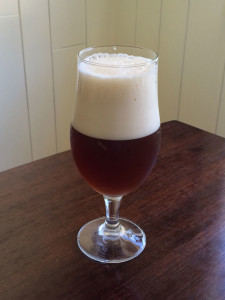I had a 6 pack of Firestone Walker’s Pale 31 a couple of weeks ago and forgot what a great beer this is. Clean, hoppy, floral, and with a tiny hint of tannic oak. Highly sessionable. Mix of their Pale Ale with 10% DBA. To recreate the DBA blend I add 1/2 oz. of oak chips. Technique I like is to throw the chips into a saucier pan and just cover with water. Bring to a boil, cool, and add to secondary when you dry hop. You could add a little Crystal 80 to add a touch of color and sweetness to mimic the 10% DBA but I don’t really think it’s a deal breaker not adding it. I did this beer a couple years before for the Ventura Winter Sudstice and it came out remarkably spot on.
6 gallons
Estimated OG: 1.046
Estimated FG: 1.008
Estimated Color: 5.1 SRM
Estimated IBU: 42.4 IBUs
Brewhouse Efficiency: 65.00 %
ABV: 4.9%
Grain
9 lbs Two Row (2.0 SRM) 76.9%
2 lbs Munich(10 SRM) 17.1%
11 oz Cara-pils (2 SRM) 6.0%
Schedule
60 minute Boil
12.00 g Chinook [13.00%] – Boil 60 min 17.8 IBUs
28.00 g Centennial [10.00%] – Boil 30 min 24.6 IBUs
28.00 g Cascade [7.0%] – Boil 0 min 0 IBUs
44.00 g Centennial [10.00%] – Boil 0 min 0 IBUs
28.00 g Cascade [7.0%] – Dry Hop 4 days
42.00 g Centennial [10.00%] – Dry Hop 4 days
16.00 g Chinook [13.00%] – Dry Hop 4 days
0.5 oz Oak Chips – Secondary 4 days(boil in small amount of water and add to secondary)
Whirfloc or Irish Moss 20 min
1tsp yeast nutrient 15 min
Mash and Sparge
1/2 Ventura water(high bicarbonates and sulfates)
1/2 RO Water
4gm calcium chloride mash water
2gm calcium chloride sparge water
Mash in 4.65 gallons water 157F and let stabilize to 148F for 60 min
Batch Sparge 4.75 gallons (.75 gallons add to mash and then sparge with remaining 4) cold sparge
Yeast
WLP 007 Dry English Ale 2L starter
